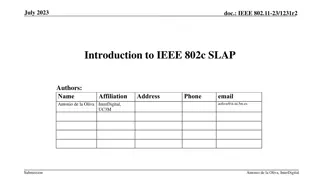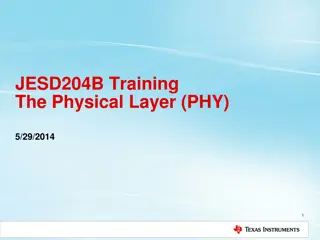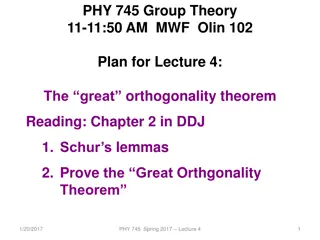Proposed Approach for MAC Address Assignment in IEEE 802.11
IEEE 802.1CQ is working on a mechanism to assign local MAC address blocks to end nodes specifically related to IEEE 802.11 standards. The current draft lacks a pre-association mechanism for IEEE 802.11 stations to obtain a local MAC address before association. The proposed remedy suggests specifying
8 views • 7 slides
IEEE 802.11-20/0095 PHY-Related Agreements for SST
IEEE 802.11-20/0095 outlines agreements related to PHY aspects impacting the definition of Spatial Stream Tapping (SST) in 802.11 standards. The focus is on enabling 80 MHz operating stations to participate in 160 MHz OFDMA, including in non-primary 80 MHz scenarios. Various considerations and scena
3 views • 11 slides
IEEE 802.11-20/0054r1 MLD MAC Address and WM Address
In the document IEEE 802.11-20/0054r1, the focus is on Multi-Link Framework for MLD address identification and differentiation. It explains the usage of MLD MAC address and STA WM medium address in wireless setups. The document also addresses the need for identifying different MLDs using MAC address
0 views • 16 slides
IEEE 802.11-21/0012r1 Considerations on Open Issues in PHY Requirements
In the January 2021 document IEEE 802.11-21/0012r1, discussions were held on open issues related to PHY requirements, including LO requirements for 320 MHz transmission, EVM requirements for 1024 QAM and BPSK-DCM-DUP, minimum sensitivity for 4K QAM and BPSK-DCM-DUP, and channel rejection levels. Sug
0 views • 12 slides
Considerations on PHY for 60 GHz in IEEE 802.11-22/1865r0 Document
The document discusses the possibility of standardizing multi-link (ML) with bands in the sub-7 GHz range combined with bands in the 45-72 GHz range, proposing reusing a sub-7 GHz PHY for mmWave bands. It explores the impact of phase noise on choosing the OFDM numerology for operation in the 45-72 G
1 views • 13 slides
IEEE 802.11-21/0391r0: Minimizing Impact in WLAN Sensing Design
The document presents discussions on minimizing impact as a design goal within the IEEE 802.11-21/0391r0 context, emphasizing the efficiency related to the impact of sensing on network performance. It addresses the current status, constraints, design options, and thoughts regarding WLAN sensing with
1 views • 8 slides
Enhancing Privacy with Randomized MAC Addresses in 802.11 Networks
This presentation discusses the use of randomized MAC addresses as a privacy-enhancing measure in 802.11 networks. Passive observation of MAC addresses poses privacy risks, and the proposal suggests assigning random MAC addresses to portable devices to mitigate tracking risks. By periodically changi
0 views • 10 slides
Privacy Issues in IEEE 802.11 Networks: Tracking and MAC Randomization
This presentation delves into the privacy concerns surrounding 802.11 networks, focusing on tracking vulnerabilities and the limitations of MAC randomization in preventing tracking. It discusses the ease of tracking devices, the risk of passive tracking due to MAC addresses being visible in frames,
1 views • 27 slides
IEEE802.15-14-0110-01-0mag MAC Timing Discussion Points for IEEE 802.15.4 Revision
Initial discussion document submitted by Benjamin A. Rolfe from Blind Creek Associates addressing MAC timing issues in the IEEE 802.15.4 standard revision. The document identifies potential problems, provides a list of questions for consideration, and outlines areas for improvement. It includes stat
0 views • 8 slides
Innovations in Wireless PHY Programming for Hardware
Programming software radios is a key aspect of wireless communication research, with recent advancements in PHY/MAC design and the use of SDR platforms like GNURadio and SORA for experimentation. Challenges include FPGA limitations and the need for hardware synthesis platforms like ZIRIA for high-le
0 views • 41 slides
Summary of MAC Address Policy Contribution to IEEE 802.11
This document outlines the contribution of MAC address policy to IEEE 802.11, focusing on defining ANQP and Beacon elements to convey information about addressing types supported by the network. It details how specific bits in the ANQP element represent support for various MAC address types includin
0 views • 5 slides
Kookmin University PHY Sub-Proposal for ISC Using CM-FSK Scheme
Kookmin University submitted a PHY sub-proposal for an ISC using a Compatible M-FSK (CM-FSK) scheme to the IEEE P802.15 Working Group for WPANs. The proposal aims to be compatible with rolling shutter image sensors by utilizing the CM-FSK modulation scheme. Design considerations include frame rate v
0 views • 31 slides
Implications of IEEE 802.11 State Machine and MAC Randomization
The document discusses the state machine transitions in IEEE 802.11, focusing on MAC address handling and implications for STA connectivity within an ESS. It explains the scenarios where a STA can use different MAC addresses, emphasizing the binding of state to specific address configurations and th
0 views • 11 slides
IEEE 802.11-21/1585r10: Identifiable Random MAC Address Presentation Summary
This presentation discusses the concept of Identifiable Random MAC (IRM) addresses in the IEEE 802.11-21/1585r10 standard. It covers the purpose of IRM addresses in preventing third-party tracking while allowing trusted parties to identify specific devices. The presentation outlines the use of Ident
0 views • 24 slides
Ultra-Reliable PHY Elements: Optimized Building Blocks for Low Latency and Efficiency
The document presents a deep dive into ultra-reliable PHY elements, focusing on achieving low latency, reduced collision, and energy efficiency. It proposes optimized universal building blocks to address these goals effectively, especially in scenarios where many devices may not receive transmission
0 views • 17 slides
How to Record Your Voice: A Comprehensive Guide for Windows, Mac, and Smartphones
Learn how to record your voice for ePoster, MP3, or podcasts using Windows 10, Mac, Android, or iPhone/iPad devices. Find step-by-step instructions for recording on different platforms, including using Windows Voice Recorder on a Windows 10 computer and QuickTime Player on a Mac. Discover tips for a
2 views • 10 slides
IEEE 802.11-24/0386r0 Lower MAC Relay Protocol Details
Detailed discussion on supporting the relay protocol in IEEE 802.11bn, covering relay addressing, end-to-end BA, relay TXOP protection, beacon forwarding, security processing, non-UHR STA support, sounding procedure, A-MPDU aggregation, de-aggregation, and more. The relay operation involves relay de
0 views • 16 slides
Evaluation Results on Payload of Pulsed Modulation PHY for IEEE 802.15-18-0171-02-0013
This document presents the evaluation results on the payload of Pulsed Modulation PHY for TG13, focusing on detection probability, BER vs SNR for header and payload, and coding considerations. It discusses the application of RS code for payload simulations and highlights the adjustments made for suc
0 views • 21 slides
Simulation Results for LC-Optimized PHY Proposal in July 2019
The document presents simulation results for an LC-optimized PHY proposal for TGbb based on G.9991 PHY. It includes details on the simulation setup, frame detection results, header modulation, coding simulation results, payload modulation, and coding simulation results. The setup involved various re
0 views • 18 slides
Lightweight Cryptography: Key-Reduced Variants and Beyond-Birthday-Bound Security
Lightweight cryptography has emerged as a hot research topic in the past two decades, with over 60 ciphers proposed. This includes examples like PRESENT, GIFT, SIMON/SPECK, and more. Authenticated encryption through CAESAR and NIST LWC plays a vital role, with ASCON and ACORN leading the lightweight
1 views • 25 slides
The Migration Advisory Committee Review and Findings
The Migration Advisory Committee (MAC) is an independent advisory body formed in 2007 to provide recommendations to the government on migration issues. The MAC does not create or implement policy but advises through research and analysis in various areas like economics, education, and stakeholder en
0 views • 13 slides
Local MAC Address Assignment Protocol (LAAP) and 802.1CQ
The Local MAC Address Assignment Protocol (LAAP) in conjunction with 802.1CQ specifies protocols and procedures for locally unique assignment of MAC addresses in IEEE 802 networks. LAAP operates in two modes - Server Mode and Peer-to-Peer Mode, ensuring efficient allocation of MAC addresses while av
0 views • 15 slides
Recap of IEEE 802.11-24/1200r1 - July 2024 Transmission Modes
This contribution discusses the harmonized waveform design and various transmission modes for active UL transmission in IEEE 802.11-24/1200r1 document. It presents multiple proposed solutions, waveform types, feasibility, and benefits of active UL transmission. The aim is to achieve optimal design c
0 views • 8 slides
Optimizing Line Coding for PM-PHY: A Detailed Analysis
Enabling line coding and channel equalization methods for PM-PHY, the IEEE 802.15.13 standard introduces overhead while enhancing channel adaptation. This contribution proposes 64b67b and Uniform Line Coding as alternative transmission modes, aiming to reduce line coding overhead while maintaining a
0 views • 26 slides
Introduction to IEEE 802c SLAP
IEEE 802c defines Local Medium Access Control (MAC) Address Usage, providing structured approaches through the Structured Local Address Plan (SLAP) in different regions of the local MAC address space. Local MAC addresses are not globally unique, and the assignment is within local administration's sc
0 views • 9 slides
JESD204B Physical Layer (PHY) in High-Speed Serial Interfaces
The JESD204B training presentation delves into the Physical Layer (PHY) of high-speed serial interfaces, covering topics such as speed grades, compliance types, SERDES solutions for long channels, clocking information, differential link data transmission, and electrical requirements for drivers and
0 views • 20 slides
Caseous Mitral Valve Calcification (C-MAC) and Stroke: Overview and Management
Caseous Mitral Valve Calcification (C-MAC) is a rare condition characterized by spectrum liquefaction necrosis of the mitral annular calcification (MAC), potentially leading to cardiovascular complications like strokes and emboli. This article discusses the features, diagnostic aspects, and treatmen
0 views • 7 slides
Enhancing MAC Header Protection in IEEE 802.11 Networks
This document discusses the need for improved protection of MAC headers in IEEE 802.11 networks to address security concerns related to certain fields that are currently not adequately protected. It emphasizes the importance of safeguarding vital information in MAC headers to prevent potential attac
0 views • 12 slides
Ethernet PHY Registers Tool Operation
The Ethernet PHY Registers Tool provides a simple way to read and write PHY registers using MDC/MDIO, aiding in development and issue debugging. This tool requires the Ethernet PHY to be connected with MDIO/MDC and initialized in a Linux environment. Pre-built binaries and source code are provided f
0 views • 9 slides
IEEE 802.11-22/0424r1 - MAAD MAC Protocol Overview
The document discusses the MAAD MAC protocol, where the AP assigns a MAAD MAC address to the STA during association. Key differences from other schemes are highlighted, emphasizing the use of MAAD MAC addresses as identification. Details on support indication, address allocation, and recognition mec
0 views • 7 slides
Relevance of Lean PHY for EHT in 6 GHz
Discussing the importance of a Lean PHY for EHT in 6 GHz to improve spectrum efficiency and reduce overhead. Introducing the Low Throughput PHY as a potential solution, highlighting its benefits compared to existing options like 802.11a. Measurement results show the impact and potential for enhancin
0 views • 14 slides
IEEE 802.11-22/0059r0 Submission for Next Generation MAC/PHY Standards
Submission by Rolf de Vegt from Qualcomm Technologies, Inc. discusses the need for a new mainstream MAC/PHY standard beyond IEEE 802.11be. The document provides insights on market context, potential timelines, and emerging market requirements for future standards development in the Wi-Fi ecosystem.
0 views • 11 slides
Kookmin University PHY and MAC Proposal for Image Sensor Communication
Kookmin University's proposal focuses on the general architecture of PHY and MAC layers for image sensor communication. The document covers design principles, compatibility features, frame formats, error correction, and various considerations related to supporting commercial cameras, frame rates, sa
0 views • 39 slides
Proposal for Integration of PHY Layer Enhancement in IEEE 802.11 Standards
This proposal suggests integrating a new PHY layer to improve throughput and robustness in frequency-selective channels, complementing existing IEEE 802.11 specifications. The document outlines the characteristics, options, and feasibility of applying the proposed enhancements within the framework o
0 views • 12 slides
Considerations on PHY Padding and Packet Extension in 11ax
The document discusses the proposed PHY padding and packet extension for IEEE 802.11ax, focusing on considerations for processing data within SIFS duration and relaxation of LDPC decoding processing time. It outlines the overview of the proposed padding scheme, considerations for LDPC implementation
0 views • 15 slides
Challenges and Proposed Solutions in Next-Generation Vehicle Technologies
The document discusses the background of IEEE 802.11 NGV technologies, focusing on the need for a new 10 MHz PHY for DSRC systems. It highlights issues related to channelization and introduces new PHY capabilities in 802.11n, 802.11ac, and draft 802.11ax standards, offering insights into evolving fe
0 views • 14 slides
Enhancement of Rule-based Random and Changing MAC Proposal in IEEE 802.11-22/1802r0
This document details the enhancements proposed for the Rule-based Random and Changing MAC (RRCM) in IEEE 802.11-22/1802r0. The RRCM concept involves generating Random MAC (RMA) addresses locally to increase security and prevent trackability in wireless networks. Key aspects include RMA generation,
0 views • 12 slides
Designing Control PHY for Millimeter Wave Communication Systems
Proposal for designing a Control PHY with low complexity and high performance for 40-50GHz millimeter wave communication systems. Focus on beamforming requirements, antenna gain, modulation schemes, spreading with Barker Sequences, and SNR enhancement. Emphasis on signal processing techniques to imp
0 views • 16 slides
Extensible Preamble Format Design
This document presents a proposal for a new extensible preamble format to address the challenges in detecting and differentiating PHY preamble formats in IEEE 802.11-15 standards. The proposed format aims to be efficient, straightforward, and easily extensible for future PHY amendments. By isolating
0 views • 15 slides
PHY 745 Group Theory Lecture 4: Great Orthogonality Theorem
The Great Orthogonality Theorem in PHY 745 lecture 4, covering topics such as Schur's lemmas and proving the theorem. Delve into Chapter 2 of DDJ1 and enhance your understanding of this fundamental concept in physics. Join the discussion on 1/20/2017 at Olin room 102 to deepen your knowledge of grou
0 views • 16 slides






































